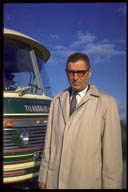Henry L. Taylor
HB Encomium of H. Taylor
Taylor, Henry Longstreet
Remarks on the 40th Anniversary of Henry L. Taylor in the Laboratory of Physiological Hygiene on Wedensday, April 30, 1980.
It’s a happy moment for all to recognize in this simple but warmly felt ceremony the 40 years of Professor Henry Taylor’s research in this Laboratory. Dr. Taylor left Harvard Medical School when it was fashionable to do that, if you were a touch consumptive, to come and take his Ph.D. here with Ancel Keys. He received the third Ph.D. granted by the Laboratory. Since that time, he has been Deputy Director or Acting Director of the Laboratory of Physiological Hygiene. His contributions to science and the Laboratory are well-known locally, nationally and internationally. They date from his classical studies of human performance leading to the measurement and use of the body’s maximal ability to consume oxygen as the platinum meter against which human work capacity can be judged. His researches continued in critical studies of the body’s responses to physical conditioning and to de-conditioning by bed rest, showing for the first time that three weeks of bed rest resulted in a terrible breakdown of cardiovascular reflexes, fully as important as damage done by illness.
A lifetime theme to his researches has been the fundamental role of physical activity and human performance in health and disease. He has over the years developed standard measurements for classifying occupational and leisure time physical activity in a quantitative way amenable to scientific applications in laboratory and in the field. He is the best known epidemiologist in the whole field of physical activity and chronic disease. He has developed the epidemiological survey methods used by this Laboratory and standards in national studies of the last two decades of population studies and preventive trials.
Just as in WWII it was said about the Royal Air Force that “Never had so few done so much for so many”, so one can say about Henry Taylor that “No one can say more by saying so little”. In the classical skilled way of Socrates, he often says it with a question. Many of you have heard the story of my first day on arriving at the Laboratory when I parked my ’41 Chevrolet coupe just outside the SOuth Tower. Confronted in my cast-off Navy khakis and overcoat and floppy felt hat on a cold fall day, towered over by the young Professor Taylor, I was greeted with the following question: “You got a permit to park here?”
It wasn’t much later when I confidently gave him the pulse count of a patient with astrial fibrillation as 140. He asked, “How repeatable is your count?” Pow!
Always he asks “What’s the evidence?” This includes such embarrassing questions as “What’s the evidence that he or she can do research?” Henry Taylor quickly and effectively separates the “real” from the “fluff”, a no-nonsense defender of the quality and integrity of scientific data. He upholds tradition, but is among the first to recognize change.
This is his tough side; but he’s a “patsy”, too, with a soft side. As the consummate diplomat he defuses situations, practicing prevention of confrontations. He is a master teacher in the tradition of one on one, feet up on the table, let’s get to the bottom of this, have it out, what is it really about?
Henry Taylor is a compassionate friend and colleague, infinitely slow to anger. I’ve only known him to be angry twice and only once was it with me; I believe the term was, “You blue-nosed such and such”.
It’s an honor for us all here today to recognize his 40 years contribution to the Laboratory and to science. To get an idea of his and the Laboratory’s relatively early influence on the field and to understand what Physiological Hygiene is, let’s go back to the early days in the Stadium Laboratory and watch a CBS TV-Special narrated by Eric Sevareid on the CVD study, “The Search“.
Henry Blackburn
